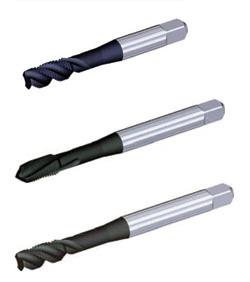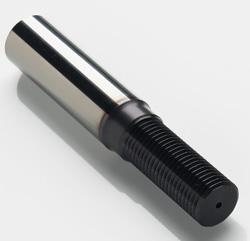- FMA
- The Fabricator
- FABTECH
- Canadian Metalworking
Tapping in the fast lane
Recent advancements in taps are helping to boost tapping speeds in high production manufacturing
- November 30, 2010
- News Release
- Metalworking
Thread milling continues to make inroads in many threading operations, but when it comes to machining deep internal threads in high production environments—where speed is critical—tapping works best say suppliers.
While a relatively new application for taps, tapping in high production environments such as automotive manufacturing, is gaining ground say suppliers who spoke with Canadian Metalworking. That’s because advancements in tap geometries, coatings (e.g. nano-layered TiAIN), tooling materials (solid carbides) and toolholders (e.g. through-coolant designs) have resulted in a new generation of faster speed (some refer to them as “full speed”) taps that are three to four times faster than their conventional cousins at tapping speeds of 100 m/min (328 sfm).
“High speed tapping is far faster than thread milling,” says Ted Henderer, a research engineer with Kennametal, based in Asheboro, NC. “We’ve seen major manufacturers, high volume/high production manufacturers convert to high speed tapping, so it’s gaining a foothold in the market.”
The Three Amigos
There are three critical aspects to achieving fast tapping speeds in high production environments: a modern CNC machine tool with a synchronous cycle; a rigid round toolholder and a solid carbide tap.
“Without any one of these three, it’s not possible to have high speed tapping,” says Kennametal’s Ted Henderer.
1. Modern CNC Machine Tool
Faster tapping is what Alan Shepherd, technical director of Emuge Corp., West Boylston, MA, calls “the Holy Grail” of machining. “The faster you can do it, the happier people are. But before you’re going to be able to tap at what we consider high speeds above conventional speeds of the day, you have to ensure the machine tool itself is a modern design.”
Indeed, Kennametal’s Ted Henderer says that “the biggest thing I see that users might not be fully knowledgeable about is the difference in machine tools...Some machine tools have spindles with high inertia and weak motor drives so they can’t accelerate and decelerate easily. Others have very low inertia and very strong motor drives, so they’re very quick. So when you buy a machine tool and want to use it for high speed tapping, this is something you need to consider.”
To increase tapping speeds, you need to have a machine with the ability to synchronize the spindle feed and rotation for fast and accurate tapping. Suppliers say that most older generation machines don’t accurately coordinate or synchronize feed and rotation during tapping, essential for producing high quality screw threads.
But with the ability to synchronize on modern CNC machine tools come some words of warning from industry experts. Synchronization errors can occur when tapping at high speeds, says Emuge’s Alan Shepherd, which can result in reduced tap life and poor thread quality.
When tapping blind-holes, Henderer has some advice.
“Not all machines have equal [synchronous tapping] capability. Since the tap and spindle must decelerate at the bottom of the hole, lead errors can occur during reversal, which causes thrust on the tap and oversized thread gauging. The most accurate machines can use a totally stiff chuck or holder. For the machines that are less accurate, what’s available to them is a synchronous tapping chuck that allows a small amount of axial movement so that if the machine is tapping off lead, it can absorb the error.”
Since the tap is still engaged with the workpiece during deceleration, tap reversal and reacceleration, Henderer advises that tapping speed should be reduced by about 40 per cent when tapping blind holes from the speeds recommended for tapping through-holes.
2. Rigid Toolholder
Rigidity is critical if you want to tap in high production environments, says Dave Vetrecin, rotating tools product manager for Iscar Canada, Oakville, ON.
“You need to ensure that the part that is going to be tapped is held rigid. Rigidity aids in better tap life, part accuracy and more consistent threads.”
Ted Henderer notes that shrink-fit and hydraulic toolholders hold the tool with greater rigidity and reduce radial runout more than flexible tapping heads.
“For example, the holder can be rotated concentrically within three microns or less, and these methods can hold a cylindrical shank with much higher gripping force and rigidity, explains Henderer. He adds that precision collet-type TGHP (tremendous grip high pressure) with high gripping force can also be used effectively, although they’re “not as desirable” as shrinkfit and hydraulic holders.
Alex Traianopoulos, marketing manager North America for Precision Dormer, Mississauga, ON, advises that “tap drivers with a controlled amount of axial float will lengthen the tool’s life. These holders reduce the amount of flank wear, both on entry and exit of the workpiece.” He adds that the wear on taps can be caused by older spindles which no longer deliver true pitch control and either underfeed or overfeed the taps.
Emuge’s Alan Shepherd says that it’s essential to have a high quality rigid tapholder and many suppliers have designed precision tapholders “that have the ability to take maximum threading production potential from modern CNC applications with synchronous rigid speed and feed controls.”
Kennametal’s Ted Henderer adds that tapholder designs that allow a slight amount of axial movement but with high rotational stiffness work best with carbide taps.
By way of example, Shepherd cites Emuge’s Softsynchro tapholder, a collet designed with a slight tension/compression—tests Emuge conducted in Germany illustrated that the slight tension/compression can eliminate problems caused b a CNC machine’s synchronization errors when tapping at high speeds.
“If there is any amount of backlash when the machine reverses, the tapholder compensates for it,” says Shepherd.
Another design component on the tapholder to consider is how the coolant is distributed through the holder to evacuate chips, says Iscar’s Dave Vetrecin. “Taps are designed specifically to tap a blind hole or a through hole. With blind hole taps, the coolant comes out straight through the end of the tap and flushed up the flutes. With through holes the coolant passes through inside the flute.”
While there are no specific coolants designed for tapping, manufacturers must take into consideration the type of material being cut and the type of tap being used for the application in a high production environment, says Craig Brydges, sales and marketing manager for Milacron Canada, Burlington, ON.
“For cut tap applications most coolants containing boundry type lubricants are sufficient. Boundry type lubricants provide an excellent barrier between the two surfaces and do not require heat or pressure to form a protective film. For roll form tapping applications heavy duty coolants containing both boundry and/or extreme pressure lubricants should be considered. Extreme pressure (EP) lubricants chemically react under conditions of high heat or pressure to enhance cutting performance. Roll form tapping applications are typically more demanding on the coolants lubrication package.”
3. Solid Carbide Taps
The ability to tap at faster speeds in high production environments is attributable to the shift to solid carbide taps.
“Most cutting tools have made the transition from HSS (High Speed Steel) to carbide. With that has come a big advantage—for taps like all other tools—in speed just by having the tool made of carbide,” says Kennametal’s Ted Henderer.
In recent years, suppliers have developed new carbide taps, some with cylindrical shanks that can be used in shrinkfit, hydraulic or precision TGHP collet holders (Kennametal) and others with innovative designs incorporating high profile relief angles (for faster tapping speeds), different shaped flutes and coolant-through technology (Emuge).
One of the big advances that cutting tool suppliers have made is the ability for taps to be used in long chip materials (carbon steel, alloy steel) in addition to short chip material (cast iron). Suppliers advise that manufacturers ensure they’re using the right tap for the application. There are different styles of taps with different flute designs for short and long chip materials. For through holes, Kennametal, for example, has a left-hand spiral fluted design for long chipping steel and for blind holes it has a right hand spiral fluted design.
Tapping will continue to play an important role in metalworking, particularly in deep hole threads, says Iscar’s Dave Vetrecin. “In certain applications tapping has some advantages over thread milling. For deep holes, tapping is a lot quicker than thread milling.”
Indeed, in one early high speed tap test that Kennametal conducted where through-holes were tapped in 32 HRC 4340 steel, TiN coated HSS taps were producing 1,500 holes at conventional speed, 50 ft/min. At 300 ft/min, the HSS taps lasted 158 holes, whereas the new carbid taps had very little wear when the test was conducted at 1,700 holes.
“High speed tapping is far faster than thread milling and it’s gaining a foothold in the market,” says Kennametal’s Ted Henderer. CM
subscribe now


Keep up to date with the latest news, events, and technology for all things metal from our pair of monthly magazines written specifically for Canadian manufacturers!
Start Your Free Subscription- Industry Events
MME Winnipeg
- April 30, 2024
- Winnipeg, ON Canada
CTMA Economic Uncertainty: Helping You Navigate Windsor Seminar
- April 30, 2024
- Windsor, ON Canada
CTMA Economic Uncertainty: Helping You Navigate Kitchener Seminar
- May 2, 2024
- Kitchener, ON Canada
Automate 2024
- May 6 - 9, 2024
- Chicago, IL
ANCA Open House
- May 7 - 8, 2024
- Wixom, MI





















